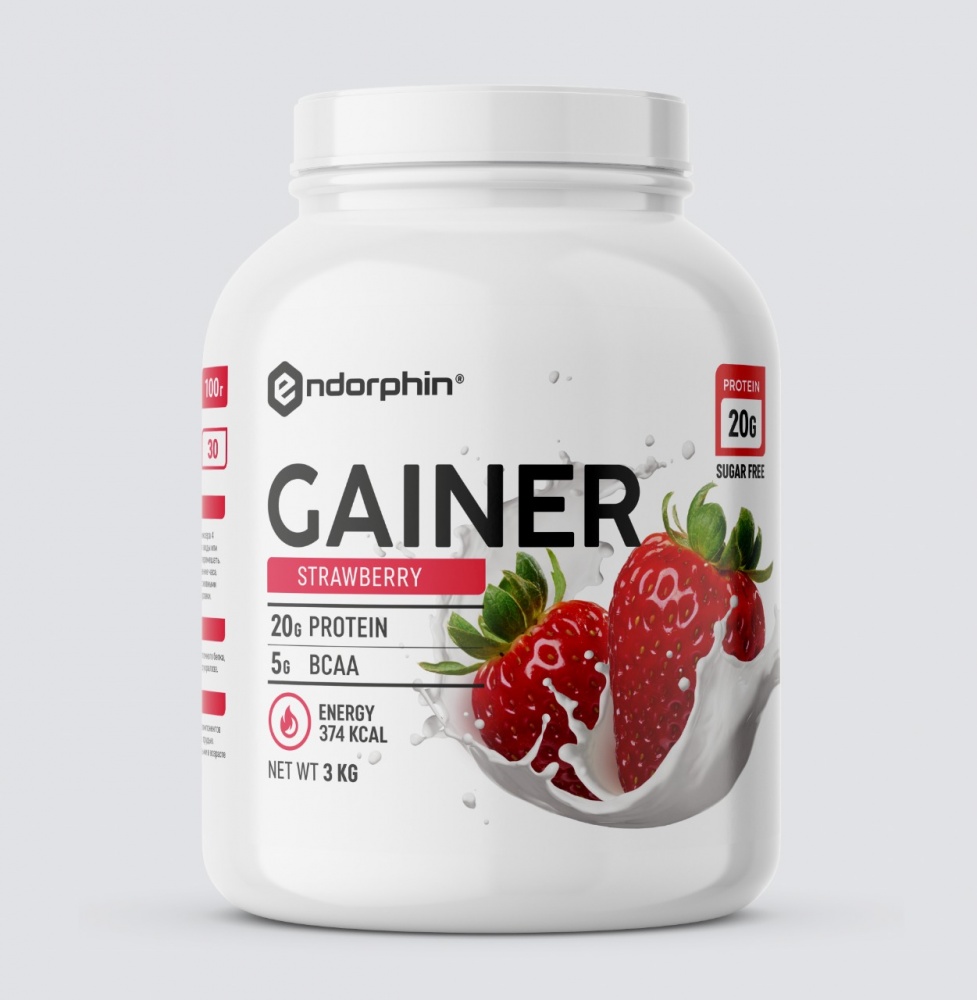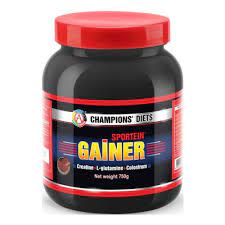
Gainer (from the English gain – gain) is a class of sports nutrition , which is a protein-carbohydrate mixture . Sometimes manufacturers add creatine , vitamins, trace elements , amino acids and other ingredients. Also, the gainer often contains a small amount of fat . The main function of a gainer is to increase body weight and quickly replenish energy reserves. The effectiveness of combining protein and carbohydrates in bodybuilding has been proven in several independent studies.
The history of the gainer is quite long, it is one of the first sports supplements. In the old days, gainers were made using cheap types of proteins, loaded with sugar and fats to maximize calories. One serving of such a gainer could contain up to 3000 calories. The protein quality was poor. Surprisingly, in Russia even now you can find such sports nutrition, nevertheless, high-quality, balanced gainers have appeared on the market, which contain purified protein with a high biological value , contain special carbohydrates and many other useful substances.
What is a gainer used for?
The gainer is intended for people with a lean physique or ectomorphs , without problematic fat deposition, who seek to gain weight in a short time. If you add three servings of this sports supplement to your regular diet and regularly engage in bodybuilding, then your mass will begin to grow steadily. For people with a fast metabolic rate, this is sometimes not enough, so you have to include additional sports supplements and raise the calorie content of the daily diet. People prone to obesity or endomorphsit is not recommended to take a gainer, since most of the carbohydrates will be deposited in adipose tissue, so it is more reasonable for them to consider protein mixtures as an additive, and consume carbohydrates mainly slow.
Also, the gainer is well suited for track and field athletes , boxers , football players , basketball players and other athletes who are exposed to prolonged aerobic exercise…. The use of a gainer before exercise allows you to maintain a high level of energy during classes and games, and after training helps to restore strength and muscles. If you follow the correct diet and weight gainer regimen, then you can easily maintain your weight at the desired level. Modern gainers are well suited not only for gaining muscle mass, but also as energy and restorers.
How to take a gainer
In bodybuilding, the most appropriate time to take a gainer is a few minutes after training. At this moment, the so-called protein-carbohydrate window opens , which can fully close the gainer. This will allow the athlete to quickly restore strength, regenerate muscle tissue, suppress catabolic processes and replenish depleted energy reserves.
Also, the gainer can be taken before training. The advantage of this moment in time lies in the fact that the body will receive an energy substrate – carbohydrates, which will allow you to train harder and longer, and a high concentration of amino acids will suppress catabolism from the very beginning of training. However, there is a significant drawback in this – during training, fat loss will not occur, and the likelihood of its gain will increase.
Some recommend taking the gainer at other times, two, three or even four times a day. There is a good reason behind this if you want to increase mass as quickly as possible and are not at all inclined to be overweight, otherwise you risk gaining mass mainly due to fat. It is much more reasonable to take a gainer 1 time, the remaining 2-3 doses should be protein.
Doses and preparation

On average, each serving of the weight gainer contains: 20-40 g of protein , 50-80 g of carbohydrates and a few grams of unsaturated fat. The amounts of other substances vary depending on the brand of the product. Do not exceed the dosage recommended by the manufacturer, as large amounts simply will not be fully absorbed. In preparation, the gainer is quite simple: a portion of dry powder is stirred in milk or water, after which it is ready for use.
Combination with other sports nutrition
The gainer works well with creatine. Carbohydrates and proteins included in it help creatine to be absorbed better and faster . They can be mixed in one cocktail and taken after training.
In addition, to make bodybuilding as productive as possible, it is advisable to also take a protein, a pre-workout complex and a vitamin-mineral complex. It goes well with anabolic complexes.
Never take a gainer during your drying, slimming, or sculpting cycles.
Gainer harm and side effects
Questions often arise: “How great is the gainer harm?” To understand the answer, you need to know – this sports supplement is created from natural food ingredients, so it is no different from ordinary products, it can be taken by both men and women, at any age. Possible individual intolerance and indigestion, especially with enzymatic deficiency due to diseases of the pancreas. Also, due to the high content of simple carbohydrates, when moisture gets in or improper storage conditions, bacteria can multiply in the product. After taking such a gainer, a typical picture of food poisoning occurs. If diarrhea occurs, take the gainer off for a couple of days and then continue at lower doses.
More specifically, you can judge only knowing the specific composition of the product.
The harm of a gainer can be equated with the question of the harm of semolina or meat, and such side effects as damage to the liver, heart and other organs, ipotence are nothing more than myths that often arise in the field of sports nutrition, due to the low awareness of even medical specialists.
Possible disorder of the digestive function with lactose intolerance. Read the main article: Lactose Free Protein & Gainer
Disadvantages and performance evaluation
As mentioned above, a gainer is a mixture of protein and carbohydrates . The cost of products is sometimes not much different from whey concentrates , which makes them economically unprofitable to purchase. If you are experiencing financial difficulties, then it is better to take more protein, while carbohydrates can be successfully obtained from food. It is believed that special carbohydrates (most often maltodextrin ) are used in gainers , however, in terms of their physiological effect, they practically do not differ from rice porridge or bakery products. In other words, a portion of the gainer can be replaced without damage with a portion of protein with a regular bun. In addition, very often a large mass fraction of soy protein is included in the composition., which has a low cost and quite a few disadvantages.
The results of the Staples AW study in 2011 ] showed that additional intake of a protein-carbohydrate mixture in a ratio of 25/50 g does not cause a greater anabolic response or inhibition of muscle protein breakdown compared to taking protein alone (25 g). This makes protein supplements the preferred choice for gaining muscle mass.
In 2016, the Journal of the International Society for Sports Nutrition published a 12-week study on the effects of post-workout protein intake (30 g whey protein), carbohydrates (34.5 g maltodextrin) and their combinations (30 g of protein + 34.5 g of maltodextrin) for strength indicators, muscle mass and percentage of fat. As a result, it turned out that in all three groups there was a decrease in fat mass, an increase in muscle mass and strength, regardless of the variant of the listed post-workout supplements. However, the whey protein group experienced a greater reduction in body fat mass than the carbohydrate group. Thus, the study supports the hypothesis that the reduction of carbohydrates in favor of protein is advisable when working on terrain.

